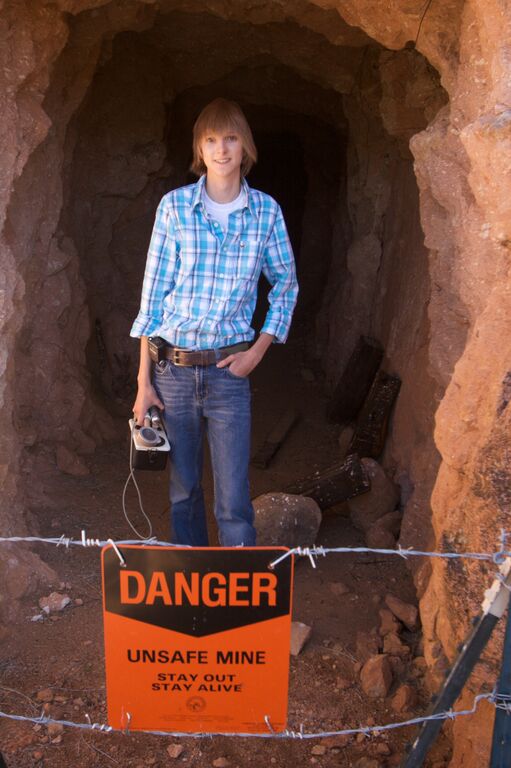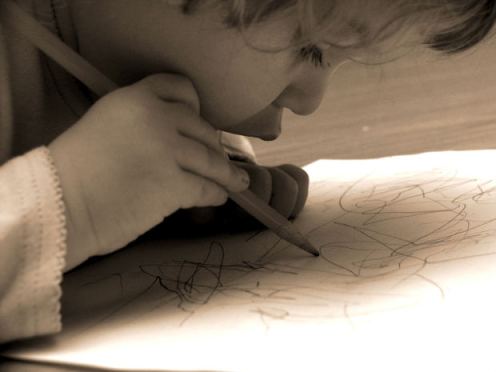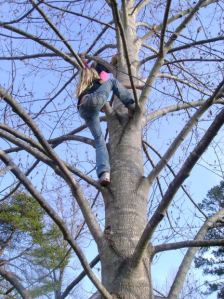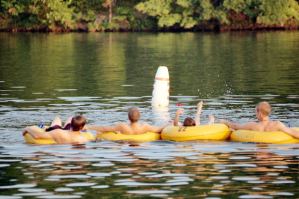Back when the boys in our regular book club were preteens and young teens, one of the books that really caught their attention was The Radioactive Boy Scout: The Frightening True Story of a Whiz Kid and His Homemade Nuclear Reactor by Ken Silverstein. It’s the true tale of David Hahn, a very gifted teen who became obsessed with learning everything he could about nuclear energy. Hahn gathered materials for experiments in all sorts of enterprising ways, even getting his hands on reactor plans. His father and stepmother forbade him from doing further experiments in the house after his efforts resulted in several chemical spills and small explosions. So he moved in with his mother and used her backyard potting shed for a hugely ambitious endeavor: building a model breeder nuclear reactor. His reactor hadn’t reached critical mass when evidence of his project was discovered during a routine traffic stop. That potting shed was deemed a Superfund site and cleaned up by the EPA in 1995.
Something astonished the boys in our group more than Hahn’s extraordinary project. They couldn’t understand why no one reached out to foster Hahn’s powerful intellect nor guided him to adult scientists who could have more safely helped him explore his interests. Maybe the boys in our group were so surprised because, as homeschoolers, we’d been accustomed to folding science interests into our days as naturally as we ate when hungry. And we’d had great success asking experts to share what they know with interested kids.
Hahn grew up, but didn’t go on to get advanced degrees or research grants. Instead he’s served in the military, been arrested for stealing smoke detectors (a source of the radioactive substance americium), struggled with mental health problems, and still does what he can to pursue his science passions with math skills he says are limited.
Hahn’s experience is radically different from that of another extraordinarily gifted teen who started investigating all things radioactive at an even younger age.
Taylor Wilson, at 14 years old, became “one of only thirty-two individuals on the planet to build a working fusion reactor.”
What’s the difference?
Do scientifically gifted kids advance due to sheer curiosity alone? Or is it absolutely essential to have parents and other adults who foster that curiosity as far as those kids want to go?
That’s a central theme in The Boy Who Played with Fusion: Extreme Science, Extreme Parenting, and How to Make a Star, a book by Tom Clynes about Taylor Wilson.
The book can be alarming, especially with the danger inherent in Taylor’s early pyrotechnic and later radioactive projects.
But it’s more alarming to consider how many children are unable to explore their gifts as Taylor and his brother did through their growing up years. The National Association for Gifted Children estimates there are three to five million gifted school aged children in the U.S. That’s about six to 10 percent of the population. And even in prestigious gifted programs, the emphasis is on college prep, giving very few young people the freedom to explore unusual interests. As Clynes warns,
Everyone’s heard the bright-kid-overcomes-all anecdotes. But the bigger picture, based on decades of data, shows that these children are the rare exceptions. For every such story, there are countless nonstories of other gifted children who were unnoticed, submerged, and forgotten in homes and schools ill-equipped to nurture extraordinary potential.
The book is also inspiring. That’s not due to Taylor’s accomplishments alone. It includes his parents and many other adults who have done everything possible to advance his interests. It’s true, few of us have the business and social connections Taylor’s father could access. He made a few calls to have a full-sized construction crane brought for Taylor’s sixth birthday party and spoke to a senator in order to get his 11-year-old son a tour of a shut-down nuclear reactor.
His parents were also able to connect Taylor with expert mentors. That’s pivotal when most high-achieving adults say having a mentor was vital to their success, yet meaningful mentorship opportunities are scarce in today’s educational environments.
The overall approach Taylor’s parents took is exactly what gifted education specialists prescribe. As Clynes writes, this has to do with “staying involved and supportive without pushing them, letting them take intellectual risks, and connecting them with resources and mentors and experiences that allow them to follow and extend their interests.”
We’ve found that supporting a child’s fascination with science (and every other subject) is about saying yes. It has little to do with spending money, more to do with putting time into expanding on a child’s interests without taking over. Clynes agrees, reminding parents that they play a pivotal role.
…We parents believe our own children deserve exceptional treatment. And the latest science actually supports our intuition that our children are gifted. A growing body of academic research suggests that nearly all children are capable of extraordinary performance in some domain of expertise and that the processes that guide the development of talent are universal; the conditions that allow it to flourish apply across the entire spectrum of intellectual abilities. Parents, the primary creators of a child’s environment, are the most important catalysts of intellectual development. While there’s no single right way to rear a gifted kid, talent-development experts say there are best practices for nurturing a child’s gifts in ways that lead to high achievement and happiness.
Here are some of those best practices.
- Starting young, expose children to all sorts of places. “Early novel experiences play an important role in shaping the brain systems that enable effective learning, creativity, self-regulation, and task commitment.” (It’s notable that Taylor’s experiences were nearly all hands-on, especially in his early years.)
- Pay attention to signs of strong interest, then offer the freedom to explore those passions. Studies show strong interests are often fleeting windows of opportunity for talent development that may fizzle if the child doesn’t have opportunities to cultivate them. “Don’t be afraid to pull your kids out of school to give them an especially rich and deep learning experience, especially when it relates to something they’re curious about.”
- Don’t worry if strong passions don’t develop early on. The learning process has a way of taking off on its own whenever kids find a passion.
- The major role for parents of children with intellectual or other passions is to facilitate, not push, by connecting them with resources that continue to expand on that interest. Emphasize opportunities for hands-on experience.
Taylor has gone on to develop a prototype that can more inexpensively produce isotopes for medical use and a radiation detector that will more easily secure borders against nuclear terrorists. He was a recipient of a two-year Thiel Fellowship and is a member of the Helena Group, a think tank of global leaders focused on world-improving projects. Taylor’s personal site is here.
Clynes closes the last page with this reminder.
Whether we use it or not, we have the recipe…parents who are courageous enough to give their children wings and let them fly in the directions they choose; schools that support children as individuals; a society that understands the difference between elitism and individualized education and that addresses the needs of kids at all levels.





















 , first names gradually move down in social class. Upper classes adopt newer names initially (according to the book, the wealthy launched names like Amber, Brittany, and Crystal). Once those names enter common usage, the upper classes shift their preferences to other first names. But overall, the
, first names gradually move down in social class. Upper classes adopt newer names initially (according to the book, the wealthy launched names like Amber, Brittany, and Crystal). Once those names enter common usage, the upper classes shift their preferences to other first names. But overall, the 








